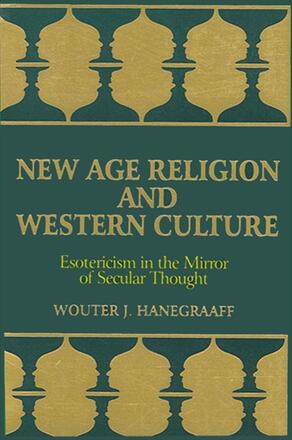Introduction
Methodology
A Preliminary Demarcation of the Field
Part One: ORIENTATION: MAJOR TRENDS IN NEW AGE RELIGION
1. Channeling
A Brief Characteristic
Channeling as Articulated Revelations
Channeling Modes and Developmental Processes
The Sources (Edgar Cayce; Eva Pierrakos; Jane Roberts; A Course in Miracles; David Spangler, Ramala; JZ Knight; Sanaya Roman; Shirley MacLaine)
2. Healing and Personal Growth
The Alternative Therapies
Healing as a Religious Phenomenon
Main Currents
The Sources (Eva Pierrakos; Ken Keyes, Leonard Orr & Sondra Ray; Shakti Gawain; Sanaya Roman; Henry Reed/Edgar Cayce; Jean Houston; Stanislav Grof; Ken Wilbur; Michael Harner; Roger Walsh; Louise L. Hay; Chris Griscom; Shirley MacLaine; Fritjof Capra)
3. New Age Science
The Quest for a Unified Worldview
New Age Science as Naturphilosophie
Main Orientations
The Sources (David Bohm; F. David Peat; Michael Talbot; Ilya Prigogine; Erich Jantsch; Rupert Sheldrake; Fritjof Capra; Ken Wilbur; Arthur M. Young)
4. Neopaganism
The Phenomenon of Neopaganism
Neopaganism as Magic
Main Orientations
The Sources (Janet & Stewart Farrar; Vivianne Crowley; Starhawk; Zsuzsanna Budapest; Marian Green; Caitlin & John Matthews; Murry Hope)
5. New Age in a Restricted and in a General Sense
Introduction
An Historical Sketch
New Age sensu stricto: The Mellenarian Vision
New Age sensu lato
The Sources ( David Spangler; George Trevelyan; Gary Zukav; Marilyn Ferguson; Fritjof Capra; Peter Russell; Willis Harman; Shirley MacLaine; Matthew Fox)
Part Two: EXPOSITION: THE VARIETIES OF NEW AGE EXPERIENCE
6. The Nature of Reality
1. Introduction: Attitudes to Experiential Reality
2. The Meanings of Holism
A. The Ultimate Source of Manifestation
B. Universal Interrelatedness
Parallellism and Bootstrap PhilosophySystems ThinkingThe Holographic Paradigm
C. Other Meanings of Holism
3. The Evolutionary Perspective
4. Some Additional Issues
The Transcendence of Space-TimeMind and MatterThe Wilbur Controversy
7. Meta-Empirical and Human Beings
1. Introduction
2. Divine Beings
A. God
B. Christ
3. Intermediate Beings
A. Beings of Amibiguous Status
B. Entities, Angels, and Other Intermediate Beings
8. Matters of the Mind
1. Introduction
2. Human Beings
A. The "I am God" Theme
B. The Constitution of Human Beings
The (Higher) SelfThe UnconsciousEgo and PersonalitySubtle BodiesThe Brain
3. The Metaphysics of Mind
A. The Psychologization of Religion and Sacralization of Psychology
B. Creating Our Own Reality
The Law of Manifestation and its ImplicationsSelf-ResponsibilityThe Mechanics of Changing Reality Creating Illness and Health
C. Inner Realms
Cartographies of ConsciousnessJourneys through Inner Space
9.Death and Survival
1. Introduction: The Experience of Death
2. Other Realities
3. Reincarnation and Beyond
New Age Reincarnation and its AttractionsThe Process and "Mechanics" of ReincarnationPast-Life Recovery
10. Good and Evil
1. Introduction: The Paradox of Ethical Holism
2. The Structure of Cosmic Justice
Non-Dual Ethics and the Problem of Relativism Evolutionist Karma
3. The Negative
Limited ConsciousnessPsychological "Negativities": Sin, Guilt, Fear
4. The Positive
Holistic ConsciousnessThe Positive: Love, Surrender, Forgiveness
11. Visions of the Past
1. Introduction
2. Beginnings
Cosmogonic MythsThe Descent of Man
3. From Atlantis to the Holy Land
AtlantisEgypt and the "Great White Brotherhood"The Essenes and Jesus
4. The Age of Pisces
ChristianityThe Rejection of ReincarnationCartesian/Newtonian Thinking
5. Historical Religious versus Universal Spirituality
Exoteric ReligiousPerennial Wisdom
12. The New Age
1. Introduction
2. The Age of Aquarius
The Timing of the New AgeThe "Pathos of Change"The "Moderate" New AgeThe Age of Light
3. The Shift from Old to New
The Potentials of CrisesEvolution of ConsciousnessThe Human Contribution: Creating Critical MassImages of Intervention
4. Epilogue: Controversies over the New Age Seneu Lato
Part Three: INTERPRETATION: NEW AGE RELIGION AND TRADITIONAL ESOTERICISM
13. Towards a Historical Perspective on New Age Religion
1. A Short Evaluation
2. Perspectives on the New Age
Hans SebaldChristof SchorschJ. Gordon Melton (cum suis)Christopher Bochinger
3. Desiderata for Academic Research
14. A Historical Framework
1. The Modern Hermeticist Revival and The Emergence of Western Esotericism
A. "Esotericism" as Technical Terminology
B. The Origins of Western Esotericism
C. The Components of West Esotericism
Philosophical Frameworks: Neoplatonism and HermeticismThe "Occult Sciences": Magic, Astrology, AlchemyThe Theosophical Component: Christian Kabbalah
D. The Worldview of Western Esotericism
2. Esotericism between Renaissance and Enlightenment
A. The "Inner Church" and Esotericism
B. The Factor of Reformation "Spiritualism"
3. A Clash of Worldviews
15. The Mirror of Secular Thought
1. Esotericism Between Enlightenment and Counter-Enlightenment
A. The Emergence of Romanticism
B. The Emergence of Occultism
Emanuel SwedenborgFranz Anton MesmerModern SpiritualismConclusion
2. The Impact of the Study of Religions
A. The Theosophical Synthesis
Proto-Theosophical PerspectivesThe New Theosophy
B. The Orient and American Transcendentalism
3. Evolution as Religion
A. The "Metaphysical" Context
B. The Theosophical Context
Spiritual Progress after DeathReincarnationThe Law of Evolution
4. The Psychologization of Esotericism
A. Harmonial Religion
American Mesmerism and the Rise of New ThoughtFunctionalist PsychologyHarmonial Religion and the Sacralization of the Psyche
B. Carl Gustav Jung
Jung and German RomanticismThe Cult of the Interior SunGnosticism, Alchemy, and Jungian Psychology
16. Conclusions: The New Age Movement and the Nature of New Age Religion
New Age as Culture CriticismNew Age as Secularized EsotericismA Final Problem: The Demarcation in TimePostscript
Appendix: Primary New Age Sources (in alphabetical order)
Bibliography
Index of Subjects
Index of Names
